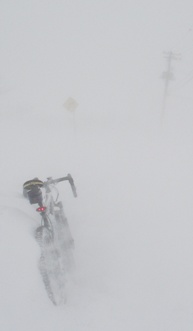




|
|
Weather at the west side of Hokkaido
Meteorological condition is an important factor for bike training.
The west coasts of Japan are well known as regions where it snows extremely because of seasonal winds.
The west side of Hokkaido makes no exception.
It frequently happens that wind speed reaches more than 30m/second, the visibility is limited to 5m, the temperature is minus 20 degrees Celsius.
Among us, Tesseract is the most experienced rider for winter.
He rode in the snow 1200km a month when he was active racer.
So he has experienced many different types of weather.
He tells that his hardest experience of riding in winter was a training in a snowstorm of 15m/second wind speed where the temperature was minus 18 degrees Celsius and the visibility was limited to 3-5m.
He has also an experience in which he couldn't see his own hands because of a strong ground blizzard.
In a strong blizzard, everything turns to be white and you can distinguish nothing.
This phenomenon is called "whiteout".
A whiteout is perilous.
When it happens, you better stop riding until the visibility becomes better because you could collide with cars, you could crash into piled snow along the road or fall out of the road.

The weather during winter is very complicated. Because seasonal winds play an important role in weather. Depressions which passed over Hokkaido move to on the Sea of Okhotsk. They strengthen there enormously and bring about strong winds between them and anticyclones on Siberia. These strong winds bring about ascending convections passing over the mountains and these ascending convections produce precipitations. So it is important to be aware of movement of depressions and their fronts in order to foresee the weather. And you better know the interval time from the cold front passage until the cold air mass covers and which wind direction brings about precipitation at most in your region. The direction is different according to the topography. The wind direction of north-northwest and northwest produce different precipitations in our region. After a strong seasonal wind, sometimes micro-depressions are formed on the Ishikari Bay. From time to time they produce more precipitation than seasonal winds. It would be better to foresee the weather to choose suitable equipments for the training because the weather in winter changes very frequently and it happens that the temperature drops by 5 degrees Celsius, a fine weather turns out to be a strong snowstorm during a single training hour alone. And you should note that the weather is very regional. If you displace 10km, the weather can be completely different since the topography has strong influence on the weather.
|